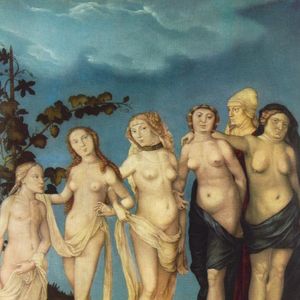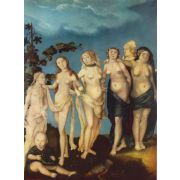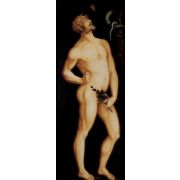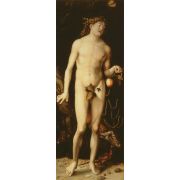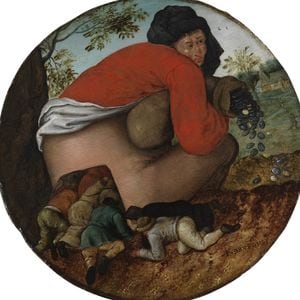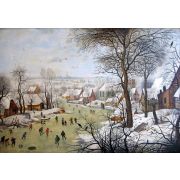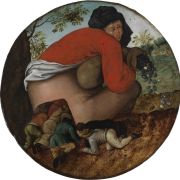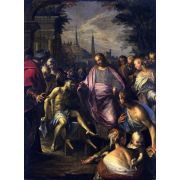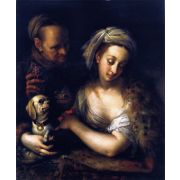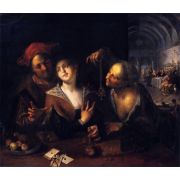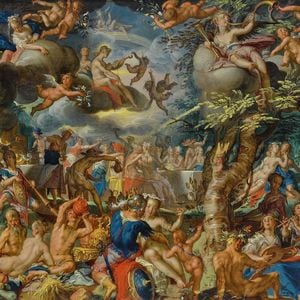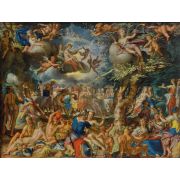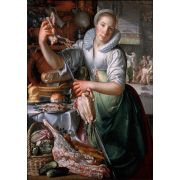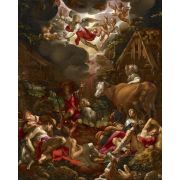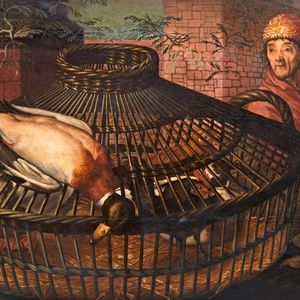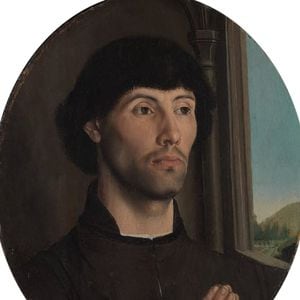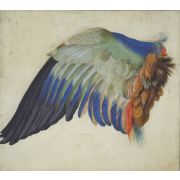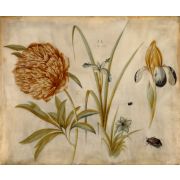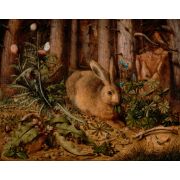
Northern Renaissance
Northern Renaissance
1 to 21 out of 21 artists
Hans Baldung
ca. 1484 -1545, German / Northern Renaissance, 102 works
Pieter Brueghel the Younger
1564 -1638, Belgian / Northern Renaissance, 61 works
Hans von Aachen
1552 -1615, German / Mannerism (Late Renaissance) and Northern Renaissance, 56 works
Joachim Wtewael
1566 -1638, Dutch / Mannerism (Late Renaissance) and Northern Renaissance, 50 works
Pieter Aertsen
ca. 1508 -1575, Dutch / Northern Renaissance, 46 works
Bernhard Strigel
ca. 1461 -1528, German / Northern Renaissance, 29 works
Jan Provoost
ca. 1462 -1529, Dutch / Northern Renaissance, 29 works
Hans Holbein the Elder
ca. 1460 -1524, German / Northern Renaissance, 27 works
Hugo van der Goes
ca. 1440 -1482, Dutch / Northern Renaissance, 23 works
Jean Fouquet
1420 -1481, French / Northern Renaissance, 17 works
Stefan Lochner
ca. 1410 -1451, German / Northern Renaissance, 16 works
Hans Hoffmann
ca. 1530 -1592, German / Northern Renaissance, 16 works
Jean Hey
1475 -1505, Dutch / Northern Renaissance, 16 works
Joachim Patinir
ca. 1480 -1524, Dutch / Northern Renaissance, 15 works
Martin Schongauer
1440 -1491, German / Northern Renaissance, 15 works
Nicholas Hilliard
ca. 1547 -1619, British / Northern Renaissance, 14 works
Konrad Witz
ca. 1400 -1446, German / Northern Renaissance, 14 works
Maarten de Vos
1532 -1603, Dutch / Northern Renaissance, 14 works
Marinus van Reymerswaele
1490 -1546, Dutch / Northern Renaissance, 7 works
Jacques Daret
1404 -1470, Belgian / Northern Renaissance, 3 works
Albrecht Altdorfer
ca. 1480 -1538, German / Northern Renaissance, 47 works
1 to 21 out of 21 artists
Around 1430, the Northern European Renaissance began when the artist Jan van Eyck started using linear perspective, naturalistic observation, and a realistic approach to painting figures from the Italian Renaissance. As artists in Germany, Switzerland, Austria, and the Low Countries started to use these ideas in their work, the Protestant Reformation came along as a reaction to Italy's high standards of beauty around the Roman Catholic Church. Extreme iconoclasm changed the way Northern Renaissance art looked. It led to decidedly simple works and showed everyday life more realistically. Art was taken off the high pedestal only the rich and powerful had used before and made available to the new, growing merchant classes.
Artists used the tradition of woodblock printing and manuscript illumination in Northern Europe. The International Gothic style of illuminating manuscripts was the best of a long line of sorts. It was shown by the Dutch brothers Herman, Paul, and Johan Limbourg, who were known for their illuminated book of prayers during the canonical hours, Très riches Heures du Duc de Berry (around 1412–1416). It was one of the first illuminated books that artists, instead of monks, made. Most of the 130 illustrations were of scenes from everyday life. Half of them were miniatures with jewel-like colors that showed court life, farm work, and military expeditions.
Robert Campin was the first famous Flemish painter. The Limbourg brothers had a lot to do with this. He was one of the first to use oil painting, a big part of the North European Renaissance. Only a few of his works are sure to be his because he rarely signed them, which was common in the Middle Ages. Since later research has shown that he was the Master of Flémalle, the Mérode Altarpiece is considered his best work (c.1428). Like most International Gothic artists, he mainly painted religious scenes. Still, his realistic paintings of everyday activities in modern settings with a symbolic meaning led the way for the Renaissance style.
Giorgio Vasari thought that Jan van Eyck invented oil painting because he was so good at it. The Ghent Altarpiece, his first great work, was made in 1432. Its oil painting and realism helped start the Renaissance in Northern Europe. After that, he was the first to paint a self-portrait (Portrait of a Man, 1433) and a portrait (The Arnolfini Portrait, 1440). (1434). His style and way of working influenced artists like Petrus Christus, Hans Memling, and Rogier van der Weyden, who lived simultaneously. Van Eyck was the only Northern European artist of the 15th century to sign his work. He sometimes said, "I Jan van Eyck was here," but more often, he said, "ALS IK KAN," which is a pun on his name and the Dutch word for art that means "As I can." His motto, "A man can do anything if he wants to," was similar to that of the Italian Renaissance architect Leon Battista Alberti: "A man can do anything if he wants to." This shows how the Renaissance saw the artist as a genius who God inspired.
Johann Gutenberg invented the printing press in 1450, spreading the idea that artists are geniuses inspired by something. For the first time, anyone who could read could read sacred texts, and artists and thinkers could publish their writing and art. Printing changed the world at the time, especially in Northern Europe. Gutenberg's Bible, which was the first German version and came out in 1455, made the holy text widely available. Even though it was printed in Latin, English and German versions came out in the 1520s. The text was now easier to read, which went along with the growing belief among Protestants that a person could have a personal relationship with God without the help of a Pope or priest. Many of the first books were religious texts, and many had pictures. This led several artists from the North to focus on printmaking for a wider audience. Artists started making single prints and series of images for the mass market, which led to a separation of style and subject.
Around 1500, artists in Northern Europe started to be influenced by what they knew about the Italian Renaissance. At first, Albrecht Dürer, a master printmaker, engraver, draftsman, and painter, was the most important person to do this. After he went to Italy in 1494–1495 and again in 1505–1507, his work began to deeply engage with the philosophical and artistic currents of Renaissance Italy and Venice. The altarpiece Feast of the Rosary is an excellent example (1506). He was influenced a lot by the colors of Venice and was very interested in humanist ideas, which led to a lifelong friendship with the German humanist Conrad Celtis. He also wrote to well-known Italian painters like Raphael. Dürer's Four Books of Human Proportion (1532) and Underweysung der Messung (1525), which were about geometry, were the first works of this kind by an artist from Northern Europe. They both talked about perspective scientifically.
In the Italian Renaissance, most outstanding works were commissioned by a few wealthy patrons, like the ruling Medici family in Florence or the Pope in Rome. In the Northern Renaissance, most arts were made for the wealthy merchant class. As cities like Antwerp became trade centers, people wanted prints, portraits, panel paintings, and even small altarpieces that they could put in their homes. Some artists worked for royal patrons, as van Eyck did for Philip the Duke of Burgundy or Dürer for Frederick III of Saxony. However, most of their money came from private patrons and a much larger audience than the Italian artists.
The social and cultural currents of the time were reflected in the art of Northern Europe. For example, Pieter Bruegel the Elder focused on the simple life, while Matthias Grünewald showed Christ in pain. Martin Luther's 95 Theses, written in 1517, critique the Roman Catholic Church's abuses and corruption. They led to the Protestant Reformation in Germany. The Catholic Hapsburg monarchy of Spain ruled the Low Countries, now Belgium, the Netherlands, and Luxembourg. They were torn by religious conflict, waves of persecution, and the destruction of many famous, idealistic religious works of art by iconoclasm. Artists found different ways to deal with the risks of the chaotic time. Early artists like van Eyck and Dürer used complicated symbols and images that could be interpreted in different ways while still fitting in with the religious atmosphere of the time. Hans Holbein the Younger and other artists of that time ran away. In his case, he moved to England and became Henry VIII's court portraitist. Cranach the Elder worked closely with the people who wanted to start the Reformation. He stopped painting myths and started painting about religion and moral satires of everyday life. His art, which showed the flaws and mistakes of people, was liked by the Protestant public and the movement's most influential thinkers.
Around 1580, the Northern European Renaissance came to an end. This was primarily because of the Eighty Years War, which started in 1568 when the Lowland countries fought against the Spanish Hapsburg government for independence and religious freedom. You could also say that when Pieter Bruegel the Elder died in 1569, the movement died with him. The war didn't end until 1648, when Belgium, the Netherlands, and Luxembourg were all recognized as separate countries. Rembrandt, Frans Hals, Jacob van Ruisdael, and Johannes Vermeer used the ideas, styles, and techniques of the Northern European Renaissance in their oil paintings and prints during the Dutch Golden Age, which came after.
Also, each Northern European Renaissance artist made a big difference for a long time. Matthias Grünewald's work influenced artists like Otto Dix and George Grosz, who were Expressionists and Neo-Objectivists, and Pablo Picasso and Max Ernst, who were Surrealists. Jan van Eyck was important to the Pre-Raphaelites in the same way that Hieronymous Bosch's work was essential to the Surrealists like Salvador Dal and Joan Miró. Hans Holbein the Younger's portraits affected Anthony van Dyck, Peter Paul Rubens, and British images starting in the 1700s. Bruegel's peasant genre started a trend in Western art: painting scenes from everyday life. This can be seen in movements like Realism (which has many different styles that are still around today), Naturalism, Impressionism, and Post-Impressionism, to name a few.
The innovations of the Northern European Renaissance had such an impact on Western art that art historian Joseph Leo Koerner, citing the realism and self-staging of Dürer and van Eyck and the unique vision of Bruegel and Bosch, has argued (rather boldly) that they, not the Italian Renaissance artists, laid the groundwork for modern art.
